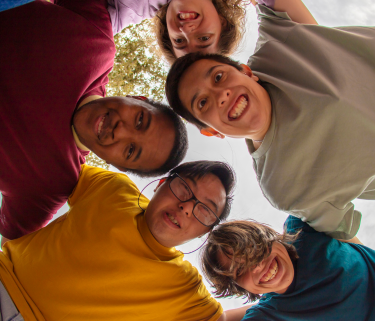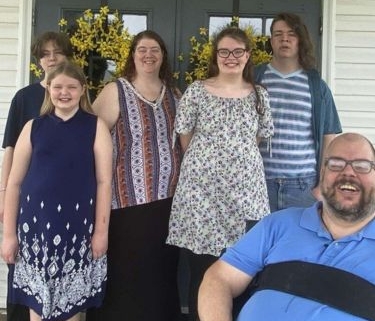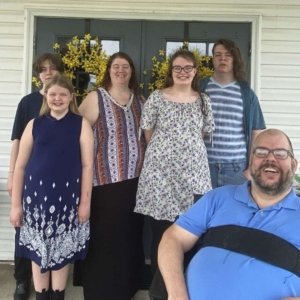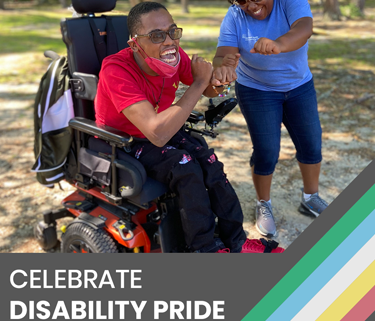They’re cheerleaders and crisis managers, nurses and advocates, therapists and service coordinators. They’re not just family members—they’re lifelines. Family caregivers are the backbone of care for people with intellectual and developmental disabilities (IDD), and their stories often go untold.
This November, for National Family Caregivers Month, we’re spotlighting seven individuals caring for their loved ones with IDD. Their insights challenge how our society views disability, family, and community.
The Arc’s 2023 Family and Individual Needs for Disability Supports (FINDS) survey highlights the need for better support systems for caregivers and their loved ones:
- Over 50% report very high or extreme stress levels
- 90% have seen their careers impacted
- More than 4 in 5 have had to provide increased support
But numbers only tell part of the story. In this blog, family caregivers of people with IDD invite us into their worlds—where challenges and triumphs coexist and where love drives everything.
The Rewards & Challenges of Caregiving
Caregivers open up about the unexpected joys and daily hurdles they face.

Debbi and Josh
Debbi Harris, mother to Josh (31) with complex medical needs: “It’s captivating to watch how Joshua navigates the complex world around him with what we consider to be so many limitations. But he has learned to use what he has in the best way he can to communicate, to gather information, to relate pain or contentment or frustration—and he’s proud of it. He has been through more medically than most people will ever experience—yet he comes back undiminished. The challenging aspect of being a parent or caregiver of a person with IDD is how the rest of the world perceives Josh. They limit his humanity and do not invest the time it takes to get to know him as the unique human that he is.”

Dena and Eli
Dena Drabek, mother to Eli (6) with a congenital heart defect: “Eli has undergone three open-heart surgeries, seven cardiac catheterization procedures, and one round of ECMO life support. Watching your child endure so much from the very beginning takes a major emotional toll as a parent. On the flip side, we have a bond unlike most because of what we have been through together. This path has also encouraged us to celebrate all of life’s little moments and be grateful for every opportunity along the way.”
Ray Hemachandra, father to Nicholas (24) with autism and intellectual disability: “Being a caregiver for someone with intellectual and developmental disabilities is no different from being a caregiver for anyone else. You work to meet the individual’s needs; honor their strengths, their uniqueness, and their beauty; and appreciate every day and every moment spent together. You ask for help when you need it, too. A challenge is asking for help in a society and culture that see lesser value in disability and in disabled lives. A challenge is navigating and overcoming a scarcity-based public support system that constantly, relentlessly requires your loved one’s deficits be documented and emphasized.”
What Caregivers Want You to Know
Caregivers share candid truths about their lives and the support they need.

Patricia and Barbara
Barbara Davis, sister to Patricia (70) with intellectual and physical disabilities: “Better funding is needed but is a low priority in state and federal budgets. Families caring for someone with IDD are just like other families — they want each member of their family to be safe and healthy and to have the opportunity to reach their fullest potential.”
Em Braman, mother to Eden (17) with Down Syndrome & OCD: “The needs of the person you are caring for always come first so you may cancel or ask to reschedule get-togethers frequently,” she shares. “This is not due to not wanting to get together with the other person, it is because my loved one comes first. Our lives just look different and just because it looks different does not mean it is bad or less meaningful. My family enjoys life and enjoys living life together.”

Jamie and Sam
Jamie Mistretta, sister to Sam (32) with intellectual disability and autism: “When a support service is unavailable, this limits my sister just as much as it limits me and my family. Her support services are what give her access to her everyday life. When a sibling or other family caregiver is sick or otherwise unavailable, our loved one still needs and deserves support.”
Mariela Azarpira, mother to Samir (22) with intellectual disability, hydrocephalus, and apraxia: “I want to tell people that it is important to fight for them, advocate for them, speak for them, include them, don’t let them give up on them, and don’t let them label them,” she asserts. “People with disabilities are perfect the way they are, so don’t outcast them and don’t allow anyone to do it. They matter too.”
Debbi Harris: “Many of our loved ones require attention 24/7 and staffing that care is a national crisis at this time. It can be exhausting. Caregivers experience chronic illnesses related to stress much more widely than others. I have chronic migraines and other stress-related health conditions. I try to write, or play the flute, or read, but I cannot focus long, and I am needed all of the time. I often feel lonely and isolated. I have my immediate family around me but find myself craving relationships I see others experiencing on social media. Even if I had the opportunity, though, I am usually exhausted and overwhelmed. I don’t have the capacity to participate socially in a normal way, and I don’t fit in. People are afraid I will talk about my son. They think their problems will seem too small or superficial, so they avoid me because they still do need to vent, as we all do. And, the aspects of caregiving I need to talk about, there is no one to listen.”
How Caregiving Shifts Worldviews
Caregivers reveal how their experiences have reshaped their outlook on life.

Eden and Em
Em Braman: “As my child gets older, I see accessibility as a much larger issue than when she was younger. It frustrates me that while she can physically access places, there are minimal accommodations to assist her in accessing the understanding needed in those locations. For example, a museum without plain language guides for the displays or a listening session where materials are not sent out ahead of time for her to read and reread for understanding or when a medical office will not let her come in ahead of time for a preview of the office to calm her anxiety.”

Mariela and Samir
Mariela Azarpira: “I am a mama bear 24/7. I am in contact with his program and aide every day asking questions like, ‘How was his day? What else do we need to do for him?’ It’s important to have clear communication with each person he is involved with daily. I want him to thrive and make sure everyone is on the same page regarding my son.”
Ray Hemachandra: “For parents of children with disabilities, the responsibility for two lives carries across the lifespan—not just caring about that person’s life, but full responsibility for the care of that life. For example, the normal fear around losing your job, getting ill, or dying is much more about what happens to your child, including your adult child, if and when that happens. Who is going to care for your child? Who is going to love your child? I wouldn’t trade my son for anything or anyone in the world. But I carry all that with me every day.”
What People Get Wrong
Caregivers set the record straight on common misunderstandings about their lives and loved ones.
Dena Drabek: “I often sense that others feel pity for our situation. The commitment I have to my son is not about what I have to give up. It’s about investing in him, nurturing his potential, and helping him discover his own unique gifts so that he can share them with the rest of the world.”

Nicholas and Ray
Barbara Davis: “There sometimes is the assumption that acting as my sibling’s caregiver is only a burden. It can be difficult, but I love my sibling. Being involved in her care is extremely rewarding.”
Ray Hemachandra: “My son isn’t a burden. He’s a blessing. When he is supported appropriately for his needs, he can contribute just as much to his family, to his community, and to our world as anyone else. He wants to know you and be your friend.”
Jamie Mistretta: “I am often asked, ‘Do you think your life would be different if your sister didn’t have a disability?’ I cannot even imagine a life where my sister doesn’t have a disability. My sister’s disability is a large part of who she is; it is a large part of her character. Disability or not, my sister will still be my maid of honor at my wedding someday. I love her for everything she is and everything she is not.”
This National Family Caregivers Month, let’s do more than recognize these hidden heroes. Let’s listen to them, support them, and work towards a world that values their essential role. Their stories show us what unconditional love and true family mean.













 Marcus Stewart’s smile lights up the room as he talks about his dreams and
Marcus Stewart’s smile lights up the room as he talks about his dreams and  Marcus’s mother, Tawana, has been his fierce advocate from day one. “When he was first diagnosed, his first geneticist told me that he’s not going to amount to much. But I said my son will get every opportunity that’s available,” she recalls. “I made myself present in workshops and other groups of parents of children with Down syndrome. I signed him up for sports. I showed up and was very vocal.” She is frustrated by the lack of opportunities for Marcus in adulthood. “Give him a chance,” she pleads. “He gets up every day without an alarm, makes his own meals, never missed a day of school, takes great care of his nephew and our two dogs. He’s more responsible than most people I know, and he’s capable of so much.” Tawana tears up and Marcus puts his arm around her shoulders.
Marcus’s mother, Tawana, has been his fierce advocate from day one. “When he was first diagnosed, his first geneticist told me that he’s not going to amount to much. But I said my son will get every opportunity that’s available,” she recalls. “I made myself present in workshops and other groups of parents of children with Down syndrome. I signed him up for sports. I showed up and was very vocal.” She is frustrated by the lack of opportunities for Marcus in adulthood. “Give him a chance,” she pleads. “He gets up every day without an alarm, makes his own meals, never missed a day of school, takes great care of his nephew and our two dogs. He’s more responsible than most people I know, and he’s capable of so much.” Tawana tears up and Marcus puts his arm around her shoulders. As we celebrate
As we celebrate 




 This Father’s Day, we’re celebrating Mike, a dad whose unconditional love and devotion are redefining society’s views on parenthood. Born with cerebral palsy, Mike has navigated life from a wheelchair, facing prejudices that often wrongly question the ability of those with disabilities to raise children.
This Father’s Day, we’re celebrating Mike, a dad whose unconditional love and devotion are redefining society’s views on parenthood. Born with cerebral palsy, Mike has navigated life from a wheelchair, facing prejudices that often wrongly question the ability of those with disabilities to raise children. His disability has no impact on his ability to empower his children’s pursuit of interests and passions, from sports to church activities. He also teaches life skills and moral values to youth as a deacon and youth counselor at his church and a coach for Junior Church. His ultimate advice to other parents with disabilities? “God chose you to raise this child – you can do it! Keep working at it and don’t give up.” His oldest is already planning for his future, with his sights set on graphics design or counseling.
His disability has no impact on his ability to empower his children’s pursuit of interests and passions, from sports to church activities. He also teaches life skills and moral values to youth as a deacon and youth counselor at his church and a coach for Junior Church. His ultimate advice to other parents with disabilities? “God chose you to raise this child – you can do it! Keep working at it and don’t give up.” His oldest is already planning for his future, with his sights set on graphics design or counseling.






